Dell Studio XPS 16: the Eyes Have It
by Jarred Walton on April 2, 2009 6:00 PM EST- Posted in
- Laptops
Gaming Performance
We've chosen to focus on "reasonable" settings for the games below. That means we run Assassin's Creed and Company of Heroes in DX9 mode at maximum detail setting - DX10 reduces performance by quite a bit in AC and by a much larger amount in CoH. We run Crysis at Medium settings (for reference, High detail drops performance almost in half: 8.8 FPS for the XPS 16 at 1680x1050). The remaining games are at maximum detail settings, but without any anti-aliasing.
Again, we chose to focus on 1680x1050 as a baseline performance comparison, and we will do so with other laptops going forward. If necessary, we will use an external LCD to run at that resolution. Besides 1680x1050, we will also include results at the native LCD resolution, and for less powerful laptops like the Studio XPS 16 we will add 1280x800 performance. (Note that performance at 1366x768 - a 16:9 aspect ratio - is virtually identical to results at 1280x800.) Ideally, you would want to run any laptop at the native LCD resolution, but depending on the game and your hardware that may not be practical.

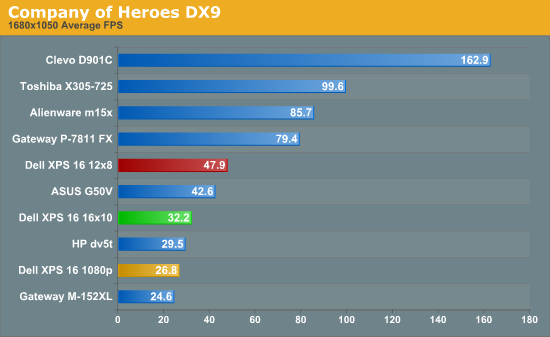
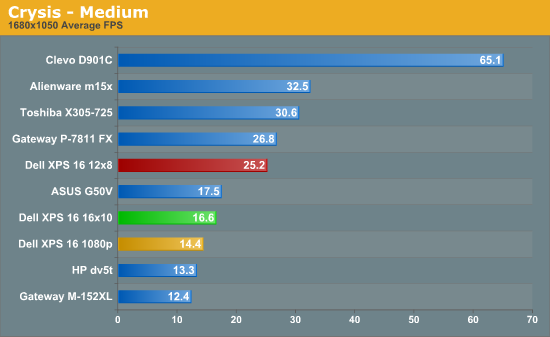
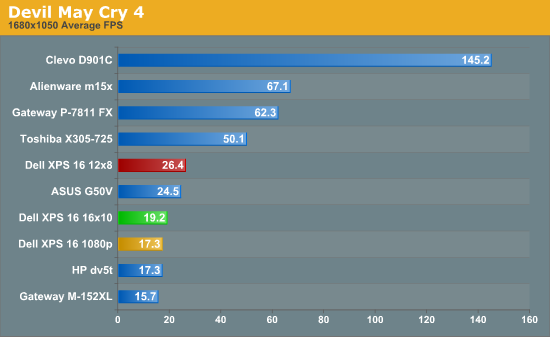
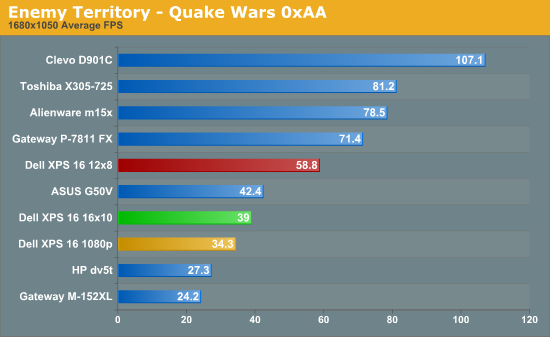
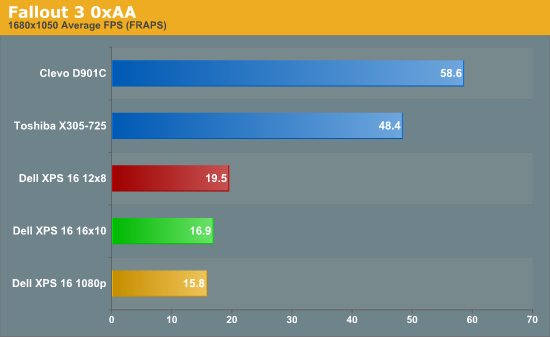
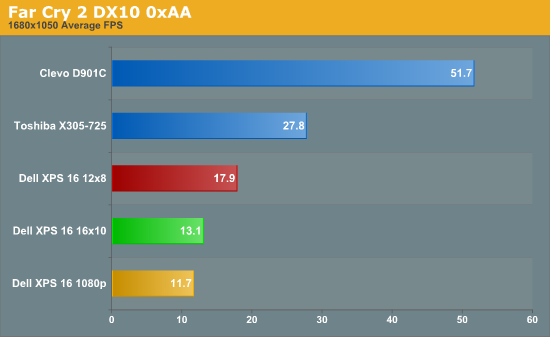
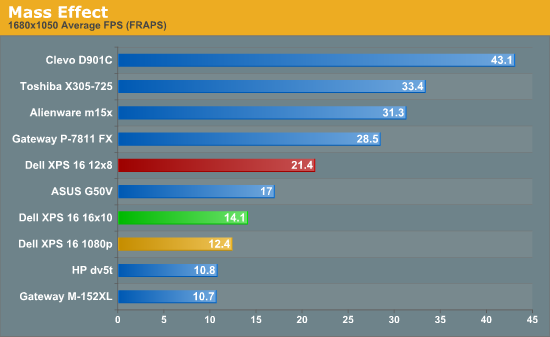

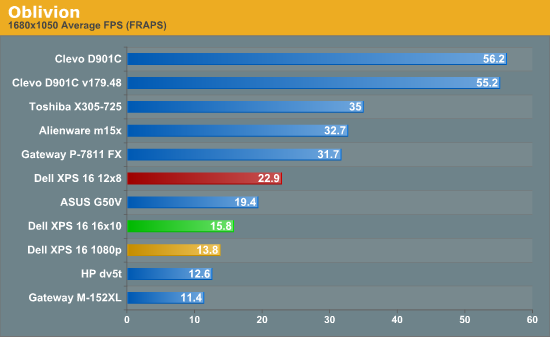
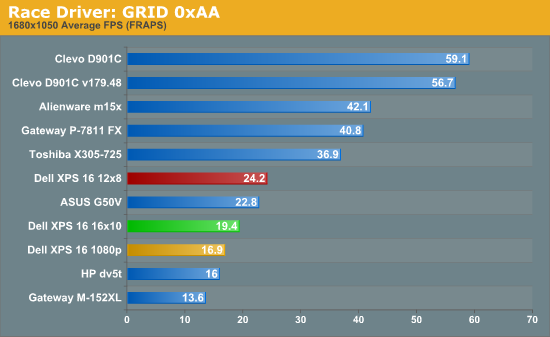
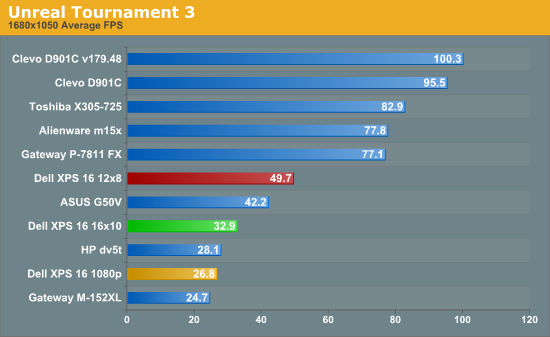
The gaming results are what you would expect from a Radeon HD 3670. If you look at the green bar, which represents equivalent performance at 1680x1050, the Studio XPS 16 is slower than the GeForce 9700M GT in the ASUS G50V but stays well ahead of the GeForce 9600M GT in the HP dv5t. Another way of looking at it is that performance at 1280x800 is almost equal to what you can get from the 9700M GT at 1680x1050; conversely, 1080p performance essentially matches the 9600M GT at 1680x1050.
As we mentioned earlier, we performed the initial benchmarks using outdated drivers. Updating to the latest drivers from Dell's website improved performance by 3-5% in several titles that we checked (Far Cry 2, Crysis, and Unreal Tournament 3). That's not a big enough change to affect the standings or our recommendation, but if you get an XPS 16 you'll want to verify that you're running the latest drivers.
Put simply, if you are interested in purchasing a laptop that can provide reasonable gaming performance, you really need at least a GeForce 9700M and preferably a 9800M - or a Mobility Radeon HD 4650 and preferably a 4830 from the ATI side. It's not that you can't game on lower end graphics solutions, but there are plenty of titles where you will need to drastically reduce resolution or detail settings in order to provide acceptable frame rates. As far as ATI versus NVIDIA goes, the latest ATI products do a great job at closing the performance gap that has existed for a while now in the mobile sector - we will have a look at a notebook in the near future that might even take the performance crown from NVIDIA.
The driver situation muddies the waters greatly, however, and we would really have a difficult time recommending against NVIDIA for a high-end gaming laptop unless and until ATI begins to offer "mobile reference drivers". Yes, it's possible to hack desktop drivers and make them work, but that definitely isn't the preferred solution. It's also a little disconcerting that when you go to ATI's website and look for Mobility Radeon drivers, many options aren't even listed - for example, the 3600 series used in the Studio XPS 16 is entirely absent. NVIDIA also has CUDA and PhysX to further tilt the scales in their favor, if you buy into the marketing. Overall, the Mobility HD 3670 is decent, but there are now better options. Unfortunately, adoption of new mobile GPUs often lags behind their official release by several months, which is why this new Studio XPS 16 uses a GPU that launched early last year.










79 Comments
View All Comments
Nfarce - Friday, April 3, 2009 - link
I have a 3 year old 17" Inspiron E1705 and still love it. When new, it played older DX9 games like Return to Castle Wolfenstein pretty well with a 2.0GHz Centrino and ATi X1400.It has the glossy screen which really helps increase the contrast appearance and really doesn't affect me because I don't use the laptop outside or next to a window. Yes, fingerprints and smudges are an issue even being as careful as possible. However, it's a small price to pay for a better picture IMO. I just don't like the "matte" screen on my Sammy 22" LCD on a gaming rig - and I think that is even harder to clean and get smudges off. Something about the grooves or something in the cover.
Finally, what's up with all these new weird LCD screen sizes these days? I use a 15.4" laptop for work and it's just too small by itself when not connected to a docking station with a monitor. And then we have the new 23" LCDs out now, and the 25.5" LCDs...
Digobick - Friday, April 3, 2009 - link
Is the 9-cell battery removable (meaning, can you take it off if you don't think you'll need it)?Also, have you weighed the laptop with the 9-cell battery installed? I'm curious to know how much it weighs with both the 9- and 6-cell batteries installed.
JarredWalton - Friday, April 3, 2009 - link
The 9-cell battery weighs a bit more than the 6-cell, probably .2 or .3 pounds. I don't have a scale that can measure such weights accurately, unfortunately, so I use the manufacturer specifications.As for the first question, the 9-cell battery is a replacement for the 6-cell; you can only use one or the other. The 9-cell is larger and raises the back of the laptop, with a .5 to 1 inch protrusion on the bottom where the 6-cell battery is flat.
andrezunido - Friday, April 3, 2009 - link
Would it be possible to have the figures for the macbook pro 15'' color gamut to compare with the Dell XPS 16?jabber - Friday, April 3, 2009 - link
You could at least have wiped the laptop down before taking the pics!That just looks sloppy. Yo did get a cloth after all.
Unless of course it was a scratched/battered review model.
JarredWalton - Friday, April 3, 2009 - link
Actually, it isn't messy at all and those aren't scratches... at least not on the laptop. That's just a reflection of the white paper I have around my photography area. The laptop surface is extremely reflective, so I'm happy it's just reflecting paper and not my face, camera, etc.jabber - Friday, April 3, 2009 - link
Hmmmmmmm still looks like the blue haze of greasy fingerprints round the edges.Just doesnt look right to me.
Please can we ditch glossy plastics now?
ksherman - Friday, April 3, 2009 - link
Apple stopped offering the choice on the MacBook Pro (and now indeed all their current computers/displays) back in November. It SUCKS. At least its a sheet of glass (supposedly) not a glossy coating.Pirks - Friday, April 3, 2009 - link
ksherman, check your facts before posting please. This is from www.apple.com online store:MacBook Pro comes with a high-resolution 1920x1200 pixel LED-backlit display. Choose a standard glossy display that lets you view graphics, photos, and videos with richer color and deeper blacks, or an optional antiglare display.
MacBook Pro 17-inch Hi-Resolution Glossy Widescreen Display
MacBook Pro 17-inch Hi-Resolution Antiglare Widescreen Display [Add $50.00]
See, Apple still offers antigare option no matter what you say.
erple2 - Tuesday, April 7, 2009 - link
Both of you are simultaneously right and wrong. The 17" Macbook Pro can be had with a either a glossy or non-glossy screen. The 15" Macbook Pro comes only with a glossy screen.